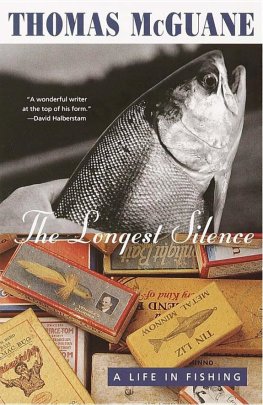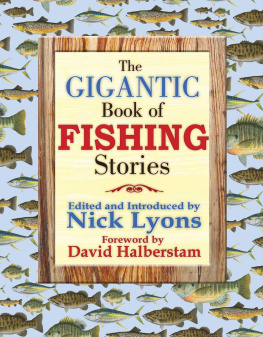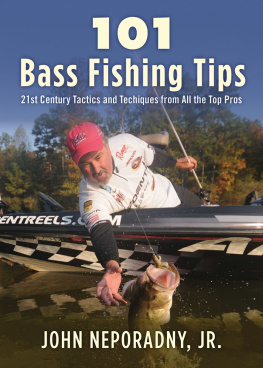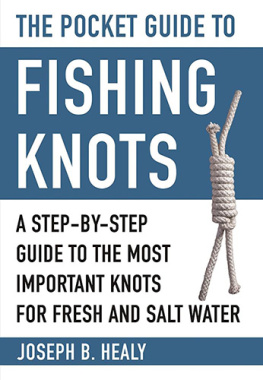THE TARPON BOOK
A Complete Anglers Guide
by
Frank Sargeant
Book III in the Inshore Series

Published by
LARSENS OUTDOOR PUBLISHING
An imprint of The Rowman & Littlefield Publishing Group, Inc.
4501 Forbes Boulevard, Suite 200, Lanham, Maryland 20706
http://www.rlpgtrade.com
Estover Road, Plymouth PL6 7PY, United Kingdom
Distributed by National Book Network
Copyright 1991 by Frank Sargeant
All rights reserved. No part of this book may be reproduced in any form or by any electronic or mechanical means, including information storage and retrieval systems, without written permission from the publisher, except by a reviewer who may quote passages in a review.
British Library Cataloguing in Publication Information Available
Library of Congress Cataloging-in-Publication Data Available
Library of Congress 91-76442
ISBN: 978-0-936512-16-4 (paper : alk.paper)
 The paper used in this publication meets the minimum requirements of American National Standard for Information SciencesPermanence of Paper for Printed Library Materials, ANSI/NISO Z39.48-1992.
The paper used in this publication meets the minimum requirements of American National Standard for Information SciencesPermanence of Paper for Printed Library Materials, ANSI/NISO Z39.48-1992.
Printed in the United States of America
ACKNOWLEDGEMENTS
Expert tarpon anglers from throughout silver king country were kind enough to share their lives and their secrets with me in the preparation of this book. Captains Ray DeMarco, Harlan Franklin, Paul Hawkins, Mike Locklear, Bill Miller, Kenny Shannon, Earl Waters and Jon Zorian were particularly instructive and generous. Also very helpful were captains Lee Baker, Dave Ballay, Charlie Cleveland, Al Dopirak, Dave Markett, Larry Mendez, and Scott Moore. Many members of the Boca Grande Guides Association and the Florida Keys Guides Association also contributed significantly, as did Billy Pate, perhaps the worlds finest and most persistent flyrod tarpon angler.
In Costa Rica, Archie Fields of Rio Colorado Lodge was a gracious host and instructor. Biologists Roy Crabtree of the Florida Department of Natural Resources and Randy Edwards of Mote Marine Laboratories deserve all the credit for the sections on the biology and migration of tarpon. And Bob Hewes, the guru of flats boats, provided many of the insights for the boating chapter. Finally, thanks to Stu Apte--one of the great pioneers of the sport--who was kind enough to take a young hopeful under his wing and offer a bit of encouragement on the Homosassa flats 20 years gone by.
Cover illustration of a battling tarpon is by St. Petersburg, Fla., artist and guide Russ Sirmons. Sirmons sculpts his exquisite works in glass with sandblasting equipment, translating what he sees on the water into accurate and exciting art that captures both the anatomical details and the spirit of his subjects. He accepts commissions for fish and birds of all species. His telephone number is (813) 526-2090.
PREFACE
This is a book about the tarpon, Megalops atlanticus, also known as the silver king, and in Central and South America as the sabalo. Whatever you call the silver giant, there are no words to describe his performance when hooked. Most world-ranging anglers agree, the tarpon is the ultimate light tackle fish, besting even the Atlantic salmon for its aerial displays, its power, and its heart. The beauty of its best-known habitat, the clear, shallow flats of the tropics, also adds to the vote for the tarpon as number one.
The book is a collection of the knowledge of dozens of truly fine tarpon fishermen, many of them acknowledged as among the worlds best. It covers finding and catching tarpon in all the vast varieties of range and habitat it enjoys, and details the use of all types of tackle for outwitting this big-eyed, big-scaled, silver giant.
The tarpons ready availability to the inshore angler makes it unique among the big-game fish, those commonly reaching more than 100 pounds. The giant silver king can be hooked as readily by the bridge and pier fisherman as by the fly-rod expert on the flats or by the sportsman trolling from the stern of a million-dollar yacht. Hes a democratic cuss, just as happily shattering drug-store spincasters as $700 fly outfits, and hes as likely to pop up 50 miles up a freshwater river as 100 miles into the Gulf of Mexico.
Tarpon have experienced the same stresses on their habitat as many other inshore species in the last 40 years, but seem to have weathered it well in many areas. They are still remarkably abundant in most of their range, and connecting with that first silver king--a high point in the growth of most anglers--is easy for anyone who takes the time to learn the basics.
The body of knowledge on tarpon is growing by tarpon-sized leaps as this text is written, with exciting new research projects revealing the secrets of biology and migration that had only been guessed at formerly. Youll find much in THE TARPON BOOK that has been printed nowhere else, much that hopefully will make you an admirer, as well as a more successful pursuer, of this unique resident of our coastal seas.
(EDITORS NOTE: Limits and other management rules mentioned throughout THE TARPON BOOK were current at printing time, but are subject to change by state and federal fishery councils. Check local laws before fishing in your area.)
CONTENTS
ABOUT THE AUTHOR
Frank Sargeant is outdoors editor of the Tampa Tribune and a senior writer for Southern Outdoors, Southern Saltwater and BassMaster magazines. He was formerly an editor for CBS Publications, and a writer for Disney World Publications, as well as southern editor for Outdoor Life. His writing and photos have appeared in a wide variety of other publications, including Field & Stream, Sports Afield, Popular Mechanics, Popular Science and The Readers Digest. He was a fishing guide before becoming a writer and editor. He holds a masters degree in English and Creative Writing from Ohio University, and has taught writing at the high school and college level. His works have won more than 40 national awards in the past decade. He is also author of the companion volumes THE SNOOK BOOK and THE REDFISH BOOK. Sargeant lives on the Little Manatee River, near Tampa, Florida.
CHAPTER 1
INTRODUCTION
SEVEN BIG GREEN TORPEDOES, coming at you in a deadly spread. Seven giant fish, carved of stainless steel, bright as swords.
Lucky seven?
Maybe lucky, this time.
The fly line sings through the guides, the fly whistles past your ear on the final ride out to the end of the leader.
For once the cast falls right, the slick fatness of the mono-core turning over the 3/0 fly just right to fall with a gentle ripple on the clear surface.
Strip it in, the line sliding between forefinger and the cork grip, short, sharp strips that make the cockroach pattern breath, dance in the slow tide.
The second fish rolls a big eye at it, fixes on it, turns her heavy head toward it as she peels out of the school.
She follows, five feet from the fly, now three, now a foot.
Tease her. Two little twitches.
The tarpon opens the gallon-bucket of a mouth and inhales it. You wait that long second for her to turn sideways, back to join her companions, then tighten the line, feel the ponderous weight, and snatch the point home with a mighty tug on the line and a powerful strike with the big 12-weight rod.
And then the whole world blows up.
The fish goes up in a twisting, head-shaking, gill-rattling explosion of saltwater, towering up there against the noonday sun, higher than your head, painting herself forever against that tropic sky, and then she falls back with a crash like a locomotive going off the end of a dock, and you are doing a mad ballet on the front deck, trying to dance that hissing fly line out from under your bare feet and get her on the reel.










 The paper used in this publication meets the minimum requirements of American National Standard for Information SciencesPermanence of Paper for Printed Library Materials, ANSI/NISO Z39.48-1992.
The paper used in this publication meets the minimum requirements of American National Standard for Information SciencesPermanence of Paper for Printed Library Materials, ANSI/NISO Z39.48-1992.